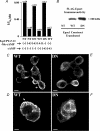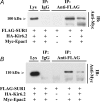cAMP sensor Epac as a determinant of ATP-sensitive potassium channel activity in human pancreatic beta cells and rat INS-1 cells
- PMID: 16613879
- PMCID: PMC1779745
- DOI: 10.1113/jphysiol.2006.107391
cAMP sensor Epac as a determinant of ATP-sensitive potassium channel activity in human pancreatic beta cells and rat INS-1 cells
Abstract
The Epac family of cAMP-regulated guanine nucleotide exchange factors (cAMPGEFs, also known as Epac1 and Epac2) mediate stimulatory actions of the second messenger cAMP on insulin secretion from pancreatic beta cells. Because Epac2 is reported to interact in vitro with the isolated nucleotide-binding fold-1 (NBF-1) of the beta-cell sulphonylurea receptor-1 (SUR1), we hypothesized that cAMP might act via Epac1 and/or Epac2 to inhibit beta-cell ATP-sensitive K+ channels (K(ATP) channels; a hetero-octomer of SUR1 and Kir6.2). If so, Epac-mediated inhibition of K(ATP) channels might explain prior reports that cAMP-elevating agents promote beta-cell depolarization, Ca2+ influx and insulin secretion. Here we report that Epac-selective cAMP analogues (2'-O-Me-cAMP; 8-pCPT-2'-O-Me-cAMP; 8-pMeOPT-2'-O-Me-cAMP), but not a cGMP analogue (2'-O-Me-cGMP), inhibit the function of K(ATP) channels in human beta cells and rat INS-1 insulin-secreting cells. Inhibition of K(ATP) channels is also observed when cAMP, itself, is administered intracellularly, whereas no such effect is observed upon administration N6-Bnz-cAMP, a cAMP analogue that activates protein kinase A (PKA) but not Epac. The inhibitory actions of Epac-selective cAMP analogues at K(ATP) channels are mimicked by a cAMP agonist (8-Bromoadenosine-3', 5'-cyclic monophosphorothioate, Sp-isomer, Sp-8-Br-cAMPS), but not a cAMP antagonist (8-Bromoadenosine-3', 5'-cyclic monophosphorothioate, Rp-isomer, Rp-8-Br-cAMPS), and are abrogated following transfection of INS-1 cells with a dominant-negative Epac1 that fails to bind cAMP. Because both Epac1 and Epac2 coimmunoprecipitate with full-length SUR1 in HEK cell lysates, such findings delineate a novel mechanism of second messenger signal transduction in which cAMP acts via Epac to modulate ion channel function, an effect measurable as the inhibition of K(ATP) channel activity in pancreatic beta cells.
Figures








Similar articles
-
Role of the cAMP sensor Epac as a determinant of KATP channel ATP sensitivity in human pancreatic beta-cells and rat INS-1 cells.J Physiol. 2008 Mar 1;586(5):1307-19. doi: 10.1113/jphysiol.2007.143818. Epub 2008 Jan 17. J Physiol. 2008. PMID: 18202100 Free PMC article.
-
Off-target effect of the Epac agonist 8-pCPT-2'-O-Me-cAMP on P2Y12 receptors in blood platelets.Biochem Biophys Res Commun. 2013 Aug 9;437(4):603-8. doi: 10.1016/j.bbrc.2013.07.007. Epub 2013 Jul 12. Biochem Biophys Res Commun. 2013. PMID: 23850619
-
Facilitation of ß-cell K(ATP) channel sulfonylurea sensitivity by a cAMP analog selective for the cAMP-regulated guanine nucleotide exchange factor Epac.Islets. 2010 Mar-Apr;2(2):72-81. doi: 10.4161/isl.2.2.10582. Islets. 2010. PMID: 20428467 Free PMC article.
-
Treating diabetes today: a matter of selectivity of sulphonylureas.Diabetes Obes Metab. 2012 Jan;14 Suppl 1:9-13. doi: 10.1111/j.1463-1326.2011.01507.x. Diabetes Obes Metab. 2012. PMID: 22118705 Review.
-
Cell physiology of cAMP sensor Epac.J Physiol. 2006 Nov 15;577(Pt 1):5-15. doi: 10.1113/jphysiol.2006.119644. Epub 2006 Sep 14. J Physiol. 2006. PMID: 16973695 Free PMC article. Review.
Cited by
-
Regulation of insulin synthesis and secretion and pancreatic Beta-cell dysfunction in diabetes.Curr Diabetes Rev. 2013 Jan 1;9(1):25-53. Curr Diabetes Rev. 2013. PMID: 22974359 Free PMC article. Review.
-
Live Cell Monitoring of Phosphodiesterase Inhibition by Sulfonylurea Drugs.Biomolecules. 2024 Aug 10;14(8):985. doi: 10.3390/biom14080985. Biomolecules. 2024. PMID: 39199373 Free PMC article.
-
Guanine-nucleotide exchange factors (RAPGEF3/RAPGEF4) induce sperm membrane depolarization and acrosomal exocytosis in capacitated stallion sperm.Biol Reprod. 2011 Jul;85(1):179-88. doi: 10.1095/biolreprod.110.085555. Epub 2011 Apr 6. Biol Reprod. 2011. PMID: 21471298 Free PMC article.
-
PKA phosphorylation of SUR2B subunit underscores vascular KATP channel activation by beta-adrenergic receptors.Am J Physiol Regul Integr Comp Physiol. 2007 Sep;293(3):R1205-14. doi: 10.1152/ajpregu.00337.2007. Epub 2007 Jun 27. Am J Physiol Regul Integr Comp Physiol. 2007. PMID: 17596331 Free PMC article.
-
Calcium signaling in vasopressin-induced aquaporin-2 trafficking.Pflugers Arch. 2008 Jul;456(4):747-54. doi: 10.1007/s00424-007-0371-7. Epub 2007 Oct 24. Pflugers Arch. 2008. PMID: 17957381 Review.
References
-
- Aguilar-Bryan L, Nichols CG, Wechsler SW, Clement JP, 4th, Boyd AE, 3rd, Gonzalez G, Herrera-Sosa H, Nguy K, Bryan J, Nelson DA. Cloning of the beta cell high-affinity sulfonylurea receptor: a regulator of insulin secretion. Science. 1995;268:423–426. - PubMed
-
- Asfari M, Janjic D, Meda P, Li G, Halban PA, Wollheim CB. Establishment of 2-mercaptoethanol-dependent differentiated insulin-secreting cell lines. Endocrinology. 1992;130:167–178. - PubMed
-
- Barnett DW, Pressel DM, Chern HT, Scharp DW, Misler S. cAMP-enhancing agents ‘permit’ stimulus–secretion coupling in canine pancreatic islet beta-cells. J Membr Biol. 1994;138:113–120. - PubMed
-
- Baukrowitz T, Schulte U, Oliver D, Herlitze S, Krauter T, Tucker SJ, Ruppersberg JP, Fakler B. PIP2 and PIP as determinants for ATP inhibition of KATP channels. Science. 1998;282:1141–1144. - PubMed
Publication types
MeSH terms
Substances
Grants and funding
LinkOut - more resources
Full Text Sources
Other Literature Sources
Molecular Biology Databases
Miscellaneous

